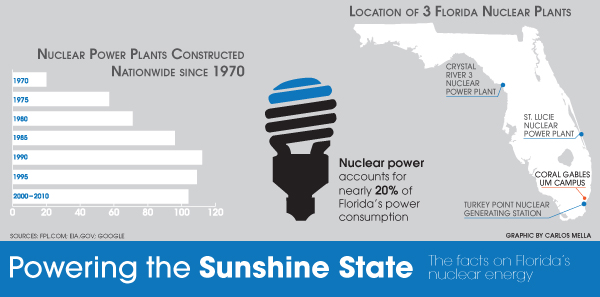
With Japan facing an alarming nuclear crisis and engineers struggling to gain control over the Fukushima Daiichi nuclear complex, some residents of South Florida worry about the impact hurricanes could have on local nuclear power plants.
About 28 miles south of the University of Miami, on a tiny jetty, the Turkey Point Power Plant has already proved its resilience in the face of natural disasters.
In 1992, when category five Hurricane Andrew hit South Florida and devastated much of Miami-Dade County, hundreds of thousands were left without power, but the Turkey Point Power Plant was able to withstand winds of up to 235 miles per hour. While a water tank in the plant was damaged in the storm, the containment buildings escaped unharmed.
“Florida nuclear power plants are built to withstand all potential environmental hazards, including earthquakes, tsunamis and the most powerful hurricanes,” said Bryan Koon, director of the Florida Division of Emergency Management in a press release.
According to the Florida Power and Light Company (FPL), Turkey Point was built to resist disaster: Its reactors were built more than 20 feet above sea level, higher than the peak 16-foot storm surge Andrew produced in Palmetto Bay just up the coast of Biscayne Bay. Also, Turkey Point is located in the lowest-hazard zone for earthquakes, as reported by the U.S. Geological Survey. And as a safety precaution, emergency managers have also cited evacuation plans that are in place to protect residents nearby within a 10-mile radius of the plant.
But South Miami Mayor Philip Stoddard, a Florida International University biology professor who campaigned against FPL expansion plans, worries evacuation plans might not be enough.
“Just look at the turnpike,” Stoddard said in an interview with The Miami Herald. “Every morning, the thing jams up from the kids going to FIU.”

The U.S. Nuclear Regulatory Commission does not feel expanding the evacuation zone, adding shelters and distributing iodide pills to residents is necessary. The agency says they regularly conduct tactical security drills that are “quite rigorous.” According to FPL’s Web site Turkey Point has successfully completed each drill.
With this positive track record in mind, FPL plans to increase the capacity of the existing four reactors at Turkey Point by a total of 400 megawatts by 2012. Currently the Turkey Point Power Plant serves half of a million homes in Miami-Dade, which is about 50 percent of the 989,435 housing units in the county, according to the 2010 U.S. Census.
But with radiation concern on the rise in Japan Stoddard says the precautions taken might not be enough at Turkey Point.
“Think of the other things that could happen,” he said. “What if somebody drops an airplane into a spent fuel pool or Castro decides to crash a MIG into Turkey Point?”
Research for this story came from miamiherald.com, nytimes.com and fpl.com.
Laura Edwins may be contacted at ledwins@themiamihurricane.com.





